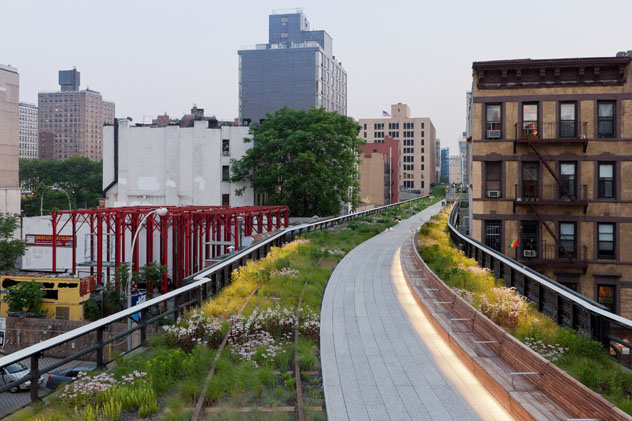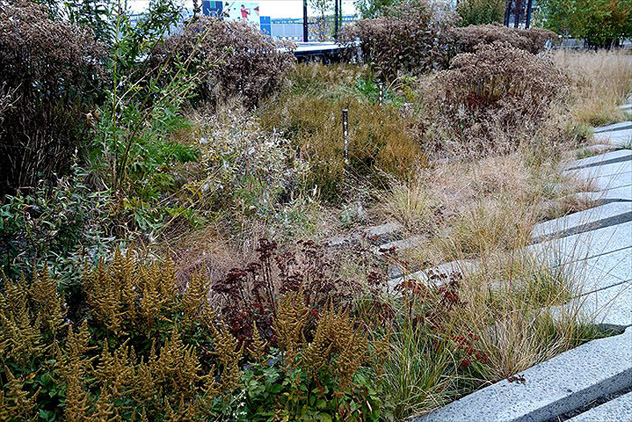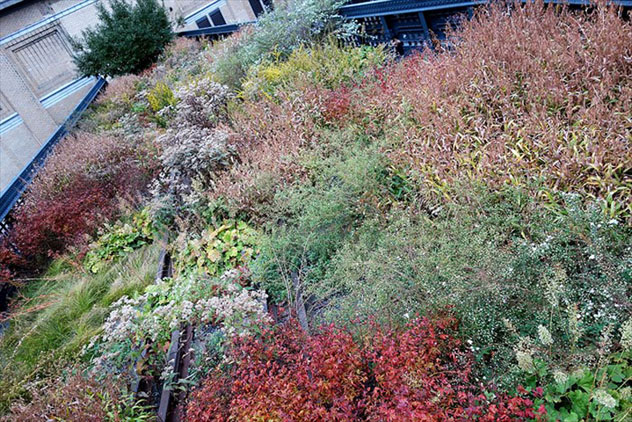photography by Iwan Baan and James Golden

1. Chelsea Grasslands, between West 19th Street and West 20th Street, looking North – photo must be credited to Iwan Baan © 2009
I began working as a garden designer in New York City in the 1990s when there was a craze for ornamental grasses that I soon discovered was a valuable plant for difficult sites. Grasses look beautiful moving in the breeze and they are tough, doing remarkably well in pots on rooftop terraces that sometimes have over 100-mile hour winds and soaring high temperatures. I didn’t realize then that there was an international garden design movement under way that was incorporating grasses into the mix with hardy resilient perennials. Some 20-plus years later we have the High Line in Manhattan with a North American native prairie-inspired planting by the Dutch designer Piet Oudolf who is the main figure of this movement. And I thought the craze for grasses was a fad!
To prepare for an upcoming garden talk I began to look into the origins and ideas behind the New Perennial Landscape Movement (TNPM). I discovered that it has been developing for 140 years and is international in scope. In this article I will focus on a few of the movement’s main figures, beginning with the Irish-born botanist and garden writer William Robinson (1838-1935) who wrote The Wild Garden (1870). Robinson favored mixing in tough ornamentals into more natural looking plantings. He worked as a botanist and studied English wildflowers. Working with native plants led him to develop a more natural style of planting based on aesthetics. He was one of the first to speak about picking the right plant for the right location and he recommended the use of grouping native shrubs and trees in the woodland. Robinson was reacting against the formal bedding out of hot house-grown annuals planted in ridged geometric-shaped beds preferred by the Victorians. His ideas were radical. He was a proponent of planting ‘crocus,’ ‘scilla,’ ‘narcissi’ and other spring bulbs in natural looking drifts. He planted cowslip and other wild flowers directly into borders. He proposed the use of hardy plants that would naturalize themselves. Frederick Law Olmsted and the English garden designer Gertrude Jekyll, along with many other designers, read The Wild Garden and were profoundly influenced by his planting philosophy.
The English Arts and Crafts Movement (1860-1910) embraced Robinson’s ideas and also looked to its own historical past, including the “cottage garden,” for inspiration. Cottage gardens are English in origin and go back 200 years. They are natural looking gardens connected to working class cottages. The plants found in these gardens were common ones such as lupines, columbines and foxgloves, often mixed with edibles such as herbs and salad. Gertrude Jekyll (1843- 1932) embodied the movement most with her bold and colorful English garden borders. In her garden, Munstead Wood, she combined a loose natural arrangement of plants that were placed in a strong garden structure of hedged rooms, pergolas, handcrafted stone terraces and walkways. The flow between house and garden was one of the most important ideas developed in arts and crafts gardens with the continuation of rooms outside into the garden. Inspired by Robinson’s focus on natural looking plantings, she created garden walks beyond garden rooms, with names such as the Fern Walk and the Woodland Walk. The arts and crafts design ideas for gardens made its way over to America and were embraced by the American Arts and Crafts Movement. To this day many landscape architect and designers are still laying out gardens using the design principals founded by this movement.
German-born Karl Foerster (1874-1970) was the next figure to add his ideas to the conversation. After training in an academy for professional gardeners and a stint on the Italian Riviera studying perennial plants under the landscape architect and plant breeder Ludwig Winter, he returned to Berlin in 1905 and took over his parent’s nursery. He retained only those plants that met his benchmark of beauty, resilience and endurance and he did away with the rest. He developed a breeding program and came up with a number of new clumping grasses, including Calamagrostis x acutiflora ‘Karl Foerster,’ as well as delphiniums and ferns. Foerster’s contribution to the movement is that he included many more grasses and much hardier perennials into the flowering borders. He was one of the key figures who influenced the New German Garden Style which rejected the stilted bedding style of the period and helped to create more ecologically made gardens. Many public and private gardens in Germany embraced his style of gardening.
Mien Ruys (1904-1999) grew up in Holland at her father’s world-class nursery and, having studied landscape architecture, she transformed her father’s land into a series of garden rooms. She accompanied her father on trips to Gertrude Jekyll’s garden in England and credits Jekyll for inspiring her own pallet of colorful perennials. Ruys would have seen many arts and crafts gardens and what emerged from this education was her own original way of laying out garden rooms that incorporated grasses and loose plantings. She described her garden philosophy as a “wild planting in a strong design.” Her main contribution to the movement is that she shows us how to move through a garden by using plants and defining spaces with bold sculptural plantings. She was very playful in her design, using positive and negative shapes. With tall hedges she would leave a narrow gap to see beyond the enclosed garden room; brick paths (positive shape) feathered out into the lawn, creating stripes of green grass (negative shapes). Although her gardens were made over 40 years ago they still look strikingly modern. View a virtual tour of her gardens at this link.
Wolfgang Oehme and James van Sweden created the New American Garden style from their landscape design firm in Washington DC. The architecturally trained van Sweden and the German plantsman Oehme began their landscape design firm in 1977 and for the next 40 years created gardens layered in perennials and grasses. Theirs was an expansive landscape inspired by the prairies of the Midwest. They paid attention to the ground plane and created a tapestry of plant communities that weave and are repeated over a large area. They were innovative designers offering an alternative to the American lawn.
The Dutch designer Piet Oudolf, with his public work here in America including the High Line and Battery Park in New York City and the Lurie Garden in the Millennial Gardens in Chicago, creates a painterly landscape with a variety of texture and colorful perennials by combining plants naturalistically. To achieve this he started a perennial nursery in 1981 with his wife Anja and spent the next decade exploring and working with perennials to figure out which ones were “good clump forming” perennials that do not move around by aggressive root systems or self-seed. In his garden book Designing with Plants, Oudolf explains how he creates his dream landscape by breaking down perennials into shapes: spires, buttons and globes, umbels, plumes and screens. His understanding of the subtle shifts of flower shapes helped me create more variety in my own garden planting.
Self-seeding plants are downplayed and perennials are chosen for their ability to endure without regular division. One of the main contributions to the movement has been using plants that have an “afterlife” and look good in the winter landscape.
TNPM has many more important figures, including Henk Gerritsen, the Dutch designer and plantman, garden writer Noel Kingsbury, and Beth Chatto, Tom Stuart Smith, Dan Pearson, and Sara Price. All are designers who have embraced the ideas.
TNPM and The Native Landscape Movement here in America share many of the same ideas over the same 140-year period. The difference between the two movements is that TNPM origins began in Europe and come out of a tradition of creating gardens based on aesthetics. TNPM incorporates hardy perennials from many countries, whereas The Native Landscape Movement is more pure in its objective focusing on “native plants communities” to each specific region. Ecology, low maintenance, and eliminating lawn come into play in both movements. I suspect most gardeners will want to draw ideas from both.
If I was to make a new garden today I would definitely lean more towards The Native Landscape Movement for inspiration. But because I have an established garden laid out in rooms I am not about to rip out my favorite ornamentals just because they’re not native. Imagine giving up tomatoes, potatoes, hollyhocks, apple trees, lilacs because they are not native. Although Jens Jensen, one of the founders of the native movement in Chicago, said you can’t really copy nature, but you can get a theme, a dominant idea, key species and key feeling. Taking a cue from him in the future I plan to choose natives over hybridized plants and to think more about plants in terms of communities. Here in the Catskills we have two wonderful garden movements to be inspired by. I will be devoting another article on The American Native Landscape Movement and its important figures.
Author’s note: Thanks to the “Friends of the High Line for the use of photos by Iwan Baan and to James Golden from Golden’s blog “View from Federal Twist” for the detail images of the High Line plantings in New York City.

4. Radial Bench,a long wooden bench curves with the pathway for an entire city block, between West 28th and West 29th Streets, looking South. Photo credit: ©Iwan Baan, 2011

5. Washington Grasslands, aerial view of the High Line over Little West 12th Street photo credit: Iwan Baan © 2009



Great article, and fascinating history lesson – thanks
Thanks Christopher!
Thanks, Don, enjoyed this concise rundown. Look forward to the next post!
Though as you point out Robinson and Jekyll would not have placed grasses in their naturalistic borders. I find grasses a jarring presence in most flower borders, which makes me an apostate, I suppose.
Ross most gardeners do not have our meadows of native grasses as a backdrop to their gardens. They might not get your aversion to using imported miscanthus and other large grasses into the mix. I for one do understand that it’s a balance when gardening on upland! Best Don
Thanks for the primer Don.
Such a lot of history. I also don’t think grasses meld well with perennials, although a garden all of grasses is a beautiful sight to behold.